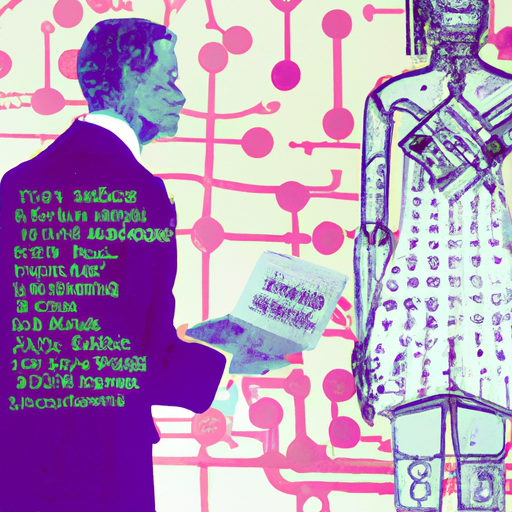
The Interection of AI and Healthcare: Addressing Health Disparities and Inequities"
-
Table of Contents
- Introduction
- Analyzing the Use of AI to Improve Health Outcomes for Marginalized Groups
- Assessing the Benefits of AI-Powered Diagnostics for Underserved Populations
- Investigating the Impact of AI on Healthcare Delivery in Low-Income Areas
- Examining the Role of AI in Reducing Health Disparities and Inequities
- Exploring the Potential of AI to Improve Access to Healthcare for Underserved Communities
- Conclusion
“Unlocking the Potential of AI to Transform Healthcare and Create a More Equitable Future.”
Introduction
The intersection of Artificial Intelligence (AI) and healthcare has the potential to revolutionize the way healthcare is delivered and experienced. AI can be used to improve the accuracy and efficiency of diagnosis and treatment, as well as to reduce healthcare costs. However, AI also has the potential to address health disparities and inequities, which are a major challenge in healthcare. AI can be used to identify and address disparities in access to care, quality of care, and outcomes. This article will explore how AI can be used to address health disparities and inequities, and the potential implications for healthcare.
Analyzing the Use of AI to Improve Health Outcomes for Marginalized Groups
The use of artificial intelligence (AI) to improve health outcomes for marginalized groups is a rapidly growing field of research. AI has the potential to revolutionize healthcare, particularly for those who are underserved or have limited access to healthcare services. AI can be used to identify and address health disparities, provide personalized care, and improve the accuracy and efficiency of healthcare delivery.
AI can be used to identify and address health disparities. AI can analyze large datasets to identify patterns and trends in health outcomes, allowing healthcare providers to better understand the needs of marginalized groups. AI can also be used to identify and address social determinants of health, such as poverty, education, and access to healthcare services. By understanding the underlying causes of health disparities, healthcare providers can develop targeted interventions to improve health outcomes for marginalized groups.
AI can also be used to provide personalized care. AI-powered algorithms can analyze patient data to identify individual risk factors and develop personalized treatment plans. This can help healthcare providers tailor care to the specific needs of each patient, leading to improved health outcomes. AI can also be used to monitor patient health and provide timely interventions to prevent or manage chronic conditions.
Finally, AI can be used to improve the accuracy and efficiency of healthcare delivery. AI-powered algorithms can be used to automate administrative tasks, such as scheduling appointments and processing insurance claims. This can reduce the burden on healthcare providers and free up resources for patient care. AI can also be used to improve the accuracy of diagnosis and treatment, reducing the risk of medical errors and improving patient safety.
In conclusion, AI has the potential to revolutionize healthcare, particularly for marginalized groups. AI can be used to identify and address health disparities, provide personalized care, and improve the accuracy and efficiency of healthcare delivery. By leveraging the power of AI, healthcare providers can improve health outcomes for marginalized groups and reduce health disparities.
Assessing the Benefits of AI-Powered Diagnostics for Underserved Populations
The use of artificial intelligence (AI) in healthcare has the potential to revolutionize the way medical diagnoses are made, particularly for underserved populations. AI-powered diagnostics can provide more accurate and timely diagnoses, leading to improved patient outcomes and reduced healthcare costs. This article will discuss the potential benefits of AI-powered diagnostics for underserved populations, as well as the challenges that must be addressed in order to realize these benefits.
AI-powered diagnostics can provide more accurate and timely diagnoses than traditional methods. AI algorithms can analyze large amounts of data quickly and accurately, allowing for more precise diagnoses. AI-powered diagnostics can also be used to detect diseases earlier, which can lead to earlier treatment and improved outcomes. Additionally, AI-powered diagnostics can reduce the need for costly and time-consuming tests, which can be especially beneficial for underserved populations who may not have access to the same resources as other populations.
AI-powered diagnostics can also help reduce healthcare disparities. AI algorithms can be trained to recognize patterns in data that may be missed by traditional methods, allowing for more accurate diagnoses for underserved populations. Additionally, AI-powered diagnostics can help reduce the burden on healthcare providers, allowing them to focus on providing more personalized care to underserved populations.
However, there are several challenges that must be addressed in order to realize the full potential of AI-powered diagnostics for underserved populations. First, AI algorithms must be trained on data that accurately reflects the population being served. If the data used to train the algorithms is biased, the results may not be accurate. Additionally, AI algorithms must be regularly updated to ensure accuracy. Finally, AI-powered diagnostics must be integrated into existing healthcare systems in order to ensure that they are accessible to underserved populations.
In conclusion, AI-powered diagnostics have the potential to revolutionize the way medical diagnoses are made, particularly for underserved populations. AI-powered diagnostics can provide more accurate and timely diagnoses, leading to improved patient outcomes and reduced healthcare costs. However, there are several challenges that must be addressed in order to realize the full potential of AI-powered diagnostics for underserved populations.
Investigating the Impact of AI on Healthcare Delivery in Low-Income Areas
The impact of artificial intelligence (AI) on healthcare delivery in low-income areas is an important topic of discussion. AI has the potential to revolutionize healthcare delivery in these areas, providing access to better care and improved outcomes. This article will explore the potential benefits of AI in low-income areas, as well as the challenges that must be addressed in order to ensure successful implementation.
AI has the potential to improve healthcare delivery in low-income areas in a number of ways. First, AI can be used to automate administrative tasks, such as scheduling appointments and managing patient records. This can reduce the burden on healthcare providers, freeing up time to focus on patient care. Additionally, AI can be used to analyze patient data, helping to identify potential health risks and providing personalized care plans. Finally, AI can be used to provide remote access to healthcare services, allowing patients to access care from the comfort of their own homes.
However, there are a number of challenges that must be addressed in order to ensure successful implementation of AI in low-income areas. First, there is the issue of cost. AI technology can be expensive, and many low-income areas may not have the resources to invest in the necessary infrastructure. Additionally, there is the issue of data privacy. AI systems require access to sensitive patient data, and there must be safeguards in place to ensure that this data is kept secure. Finally, there is the issue of access. Many low-income areas may not have access to reliable internet or other necessary infrastructure, making it difficult to implement AI-based healthcare solutions.
In conclusion, AI has the potential to revolutionize healthcare delivery in low-income areas, providing access to better care and improved outcomes. However, there are a number of challenges that must be addressed in order to ensure successful implementation. These include the cost of AI technology, data privacy concerns, and access to reliable infrastructure. With the right strategies in place, AI can be used to improve healthcare delivery in low-income areas, providing access to better care and improved outcomes.
Examining the Role of AI in Reducing Health Disparities and Inequities
The use of artificial intelligence (AI) in healthcare has the potential to reduce health disparities and inequities. AI can be used to identify and address health disparities and inequities by providing more accurate and timely diagnoses, improving access to care, and providing personalized treatments.
AI can be used to identify health disparities and inequities by analyzing large datasets to identify patterns and trends in health outcomes. AI can also be used to identify populations that are at risk of developing certain health conditions, such as diabetes or heart disease. By identifying these populations, healthcare providers can target interventions to reduce health disparities and inequities.
AI can also be used to improve access to care. AI-powered chatbots can provide personalized health advice and connect patients to healthcare providers. AI-powered virtual assistants can also help patients navigate the healthcare system and access the care they need.
Finally, AI can be used to provide personalized treatments. AI-powered algorithms can analyze a patient’s medical history and current health status to provide personalized treatment plans. AI-powered systems can also be used to monitor a patient’s health and provide real-time feedback to healthcare providers.
In conclusion, AI has the potential to reduce health disparities and inequities by providing more accurate and timely diagnoses, improving access to care, and providing personalized treatments. By leveraging the power of AI, healthcare providers can target interventions to reduce health disparities and inequities.
Exploring the Potential of AI to Improve Access to Healthcare for Underserved Communities
The potential of artificial intelligence (AI) to improve access to healthcare for underserved communities is immense. AI can be used to identify and address health disparities, provide more personalized care, and reduce healthcare costs.
AI can be used to identify health disparities in underserved communities. AI-driven analytics can analyze large datasets to identify patterns and trends in health outcomes. This can help healthcare providers identify areas where health disparities exist and develop targeted interventions to address them.
AI can also be used to provide more personalized care to underserved communities. AI-driven technologies such as natural language processing and machine learning can be used to analyze patient data and provide personalized recommendations for care. This can help healthcare providers tailor treatments to the individual needs of their patients.
Finally, AI can be used to reduce healthcare costs for underserved communities. AI-driven technologies can automate administrative tasks, such as scheduling appointments and processing insurance claims. This can help reduce the cost of providing healthcare services to underserved communities.
In conclusion, AI has the potential to improve access to healthcare for underserved communities. AI-driven analytics can identify health disparities, AI-driven technologies can provide more personalized care, and AI can reduce healthcare costs. By leveraging the power of AI, healthcare providers can ensure that underserved communities have access to the care they need.
Conclusion
The intersection of AI and healthcare has the potential to revolutionize the way healthcare is delivered and accessed. AI can help to reduce health disparities and inequities by providing more accurate diagnoses, better access to care, and improved patient outcomes. AI can also help to reduce costs and improve efficiency in healthcare delivery. However, it is important to ensure that AI is used responsibly and ethically, and that it is used to benefit all members of society, regardless of their socio-economic status. With the right safeguards in place, AI can be a powerful tool for addressing health disparities and inequities.








